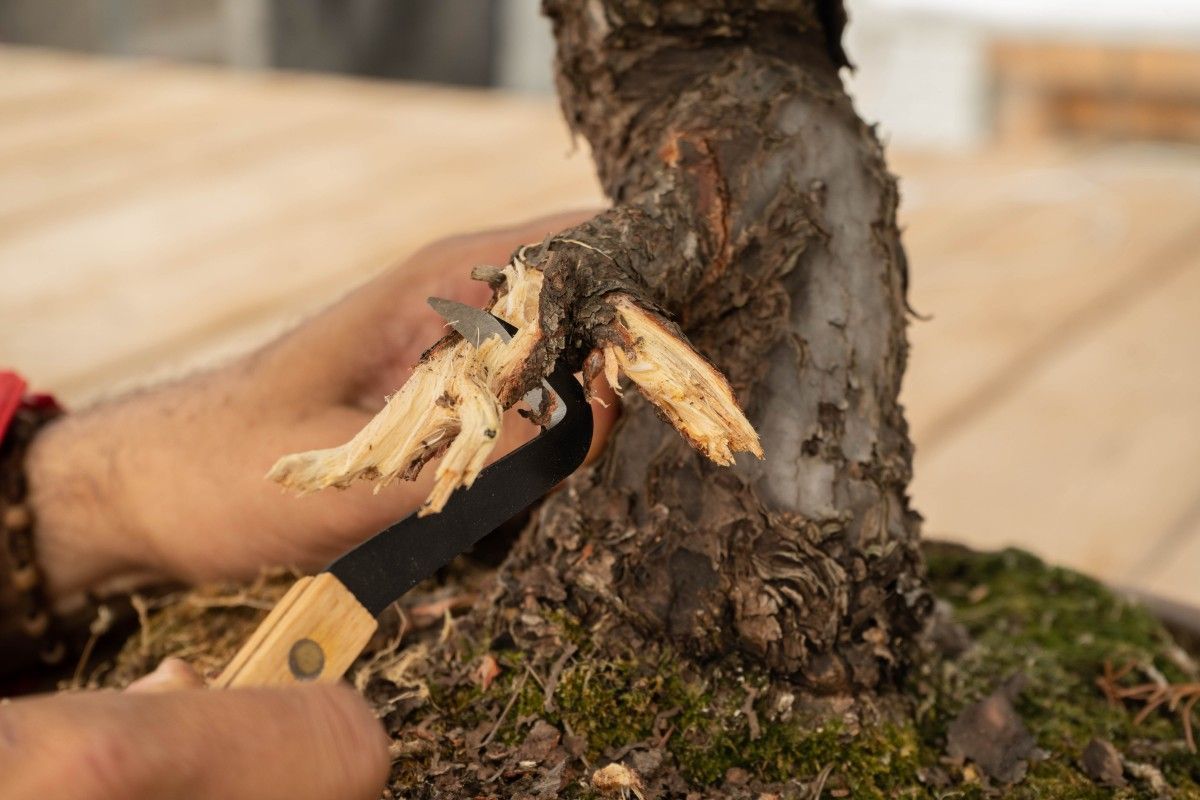The basic tools for working dead wood

Working dead wood can significantly mark the character and appearance of your bonsai. The dry wood of each tree has to be treated uniquely. The dry wood of deciduous trees is very different from that of junipers; as for its shapes and colors.
Autumn is here. It is an ideal time to work dead wood. Do you want to review what are the basic tools that you will need to achieve a competition dead wood for your bonsai?
Cutting pliers:
Essential tool to get clean and tight cuts, which heal easily. Its concave blades allow almost perfect cuts.
The chisel and the hammer:
These tools serve to go breaking the dead wood in those areas of flat or very regular cuts. They are also ideals and very useful for reducing large areas.
The trunk Splitter or pincer to divide the trunk:
Very useful tool when we start making a Jin. Its sharp edges penetrate the branch and separate it longitudinally. Then with the Jin pliers, we can tear and make the most natural finish.
The gouges:
The gouges allow us to start modelling or designing dead wood, since its different blades (oval, flat, round, triangular), permit to create different textures, grooves and reliefs that generate interest of our dead wood.
Both when working with a chisel and hammer, and when working with gouges, we should remember that the tree must be well fixed to the pot so that it does not move so much, and thus doesn’t break the small roots of the tree under the movements and impact of the tools.
The work with gouge, chisel, and the help of Jin pliers, permit to do a more natural work and a more effective tearing.
(Jin) Carving or grafting knife:
This sharp knives permit to create the first surfaces of the Jin and carve them by removing the bark.
Jin Sickle or draw knife :
The Jin Sickle, or draw knife, is a tool that will help us remove the bark and sculpt a Jin in hard-to-reach and angle parts.
Jin plier:
Jin plier is used to strip the bark and tear the branches, turning them into Jin. This tool achieves a cleaner and more natural surface of Jin tearing.
Deadwood brushes:
These deadwood brushes usually come in trio. A brush with nylon bristles, one with iron or aluminum bristles and another with brass bristles.
The brush with nylon bristles is used to remove green mold or to clean dirty dead wood from dust or dirt. Water is placed on the dead wood and then it is brushed.
Brass or iron brushes are used to create a more polished surface, softer touch; They serve to remove the wood shavings left on the Jin or Shari, after the wood has been teared to create them.
If you do not have any of these tools at your disposal, you can find cases that already contain a set of specific tools for woodworking.
The creation of a jin or shari requires experience. Learning to work wood is like learning to drive a car. Only practice will allow us to break wood effectively. Through it, we will discover the hidden beauty of our bonsai, which is the basis of dry wood work.
If you want to know more about dead wood, do not miss the two specific monographs of Bonsai Pasión magazine nº. 77 and 78 (Spanish) or France Bonsaï magazine n°105 and 106 (French). There you will find everything about the origin of dead wood and classification, typical forms in bonsai, as well as the different techniques for woodworking, concrete example by masters such as Mr. Terasawa, Tatsuya and Kimura, and everything needed to help you see the dried wood of your bonsai in a different way.
About the Author
Luis Alejandro Herrera
Spreading the art of bonsai is his passion. As a reference in the Latin American bonsai world, Luis studied and participated as an instructor for more than 15 years within the Venezuelan Bonsai Society. He had the opportunity to expand his knowledge with great masters from the world of bonsai like Pedro Morales, Nacho Marín; and within the European school with the Italian teacher Salvatore Liporace. He managed to be in the first place of the Caracas 2016 New Talents Contest and successfully completed the master class of the European School of Bonsai in Puerto Rico. During his career he has been a permanent instructor of the Venezuelan Society of Bonsai.
Categories
Bonsai cultivation and care (60)
Bonsai gift (2)
Bonsai pests and diseases (7)
Bonsai repotting (3)
Bonsai species (1)
bonsai substrates (2)
Bonsai summer (1)
bonsai tools (1)
Bonsai work (13)
Ceramic pots (3)
Chinese culture (1)
Chinese culture (2)
Coniferous bonsai (2)
Conifers (1)








